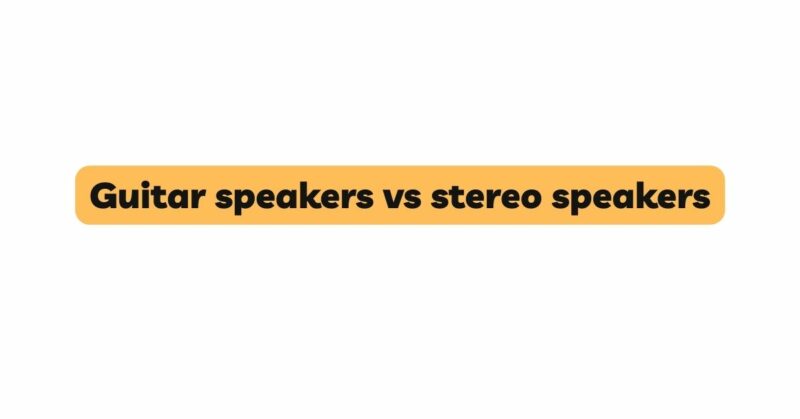In the world of audio reproduction, the distinction between guitar speakers and stereo speakers is often a point of curiosity and confusion. Both types of speakers serve unique purposes in delivering sound, catering to specific musical and audio needs. This article delves into the intricacies of guitar speakers and stereo speakers, highlighting their differences, applications, and the factors that set them apart in the realm of sound reproduction.
Understanding Guitar Speakers:
Role in Sound Reinforcement: Guitar speakers are specialized components designed to reproduce the unique tonal characteristics of electric guitars. Unlike stereo speakers, which are engineered to reproduce a wide range of audio frequencies with accuracy, guitar speakers are optimized to emphasize certain frequency ranges that enhance the character and timbre of the guitar’s sound.
Focused Frequency Response: Guitar speakers typically exhibit a narrower frequency response, emphasizing midrange frequencies where the guitar’s fundamental tones and harmonics reside. This tailored response allows guitarists to achieve the desired tonal characteristics and nuances that define their playing style.
Characteristics and Cabinet Design: Guitar speakers are often characterized by their coloration of sound. This coloration, known as “voicing,” results from the combination of the speaker’s design, materials, and cabinet enclosure. Guitar cabinets are carefully designed to work in harmony with specific speaker models to produce the desired sonic characteristics.
Applications of Guitar Speakers:
- Live Performances: Guitar speakers are a staple on stage, delivering the distinct sound of electric guitars to the audience. Their focused frequency response and tonal coloration contribute to the iconic guitar tones heard in various music genres.
- Recording Studios: In recording studios, guitar speakers are used to capture the unique sound of different guitar amplifiers. Engineers often experiment with various speaker and microphone placements to achieve the desired guitar tone.
- Amplifier and Cabinet Matching: Guitarists often select amplifier and cabinet combinations based on their preferred tonal characteristics. The pairing of specific amplifier heads with compatible cabinets and speakers contributes to the overall guitar sound.
Understanding Stereo Speakers:
Versatility in Audio Reproduction: Stereo speakers are designed to reproduce a wide range of audio frequencies across the entire audible spectrum. Their goal is to deliver sound with accuracy and fidelity, allowing listeners to experience music, movies, and other audio content in its intended form.
Balanced Frequency Response: Unlike guitar speakers, stereo speakers offer a balanced frequency response that covers lows, mids, and highs. This even response ensures accurate reproduction of various musical instruments and audio elements, offering a true representation of the recorded content.
Characteristics and Cabinet Design: Stereo speakers prioritize clarity, accuracy, and neutrality. Their design and construction focus on minimizing coloration or distortion, allowing listeners to hear music as it was intended by the artists and producers.
Applications of Stereo Speakers:
- Home Audio: Stereo speakers are commonly used in home audio setups to reproduce music, movies, and other audio content with precision and clarity. They provide a versatile and immersive listening experience across various genres.
- Studio Monitoring: In recording studios, stereo speakers serve as reference monitors for mixing and mastering audio tracks. Their accurate reproduction helps engineers make informed decisions about sound balance, dynamics, and effects.
- Multimedia Applications: Stereo speakers are ideal for multimedia setups, including computers, televisions, and home theaters. They offer a well-rounded audio experience for a range of content types.
Comparing Guitar Speakers and Stereo Speakers:
- Frequency Response: Guitar speakers have a focused frequency response tailored to electric guitar tones, while stereo speakers offer a balanced and even response across the entire audible spectrum.
- Tonal Coloration: Guitar speakers intentionally color the sound to enhance specific tonal characteristics, while stereo speakers aim for neutrality and accuracy.
- Use Cases: Guitar speakers are designed for live performances, recording guitars, and amplifier-cabinet matching. Stereo speakers excel in home audio, studio monitoring, and multimedia applications.
- Voicing vs. Fidelity: Guitar speakers prioritize voicing and character, while stereo speakers prioritize audio fidelity and accuracy.
Conclusion:
The distinction between guitar speakers and stereo speakers lies in their design, purpose, and application. Guitar speakers are tailored to emphasize certain frequencies that enhance electric guitar tones, offering iconic coloration and character. On the other hand, stereo speakers are versatile, aiming for accurate and balanced audio reproduction across various content types. Each type of speaker serves its own specialized role in the realm of sound reproduction, catering to the unique needs and preferences of guitarists, audiophiles, engineers, and listeners. Understanding these differences empowers individuals to make informed choices when selecting the right speakers for their musical and audio endeavors.


